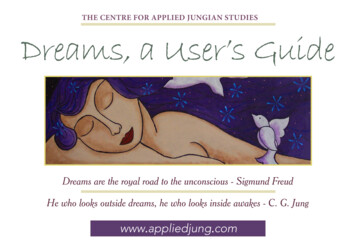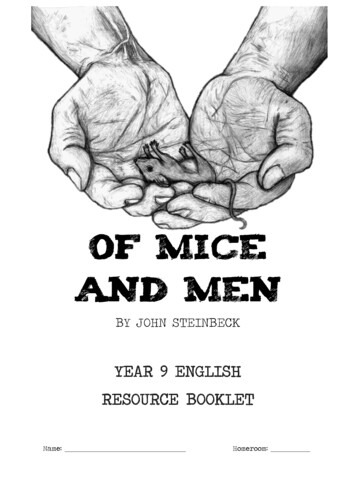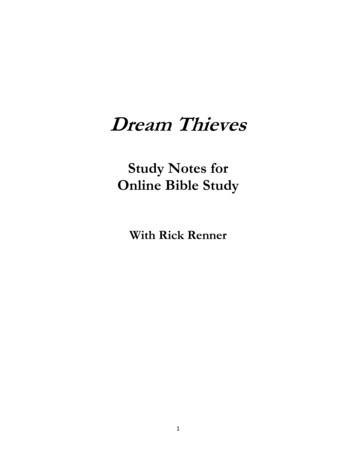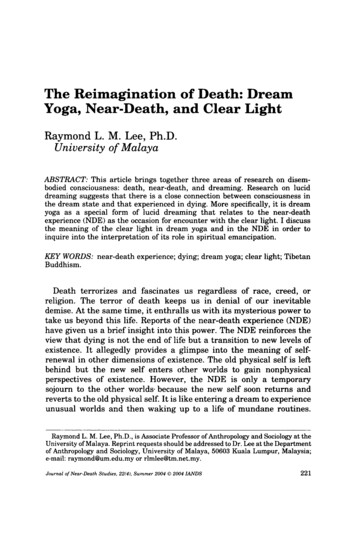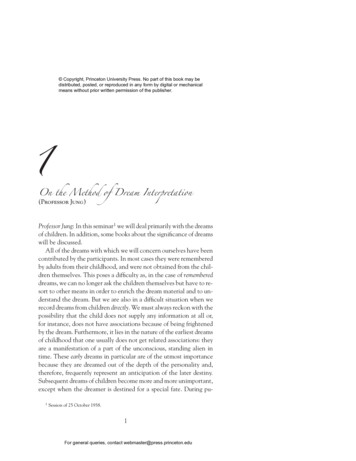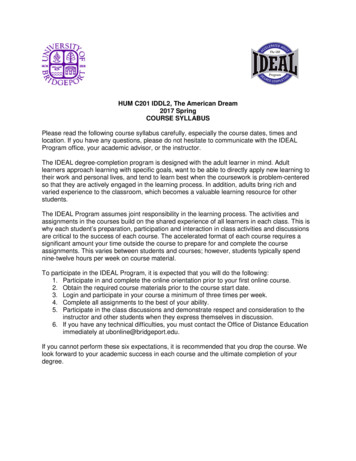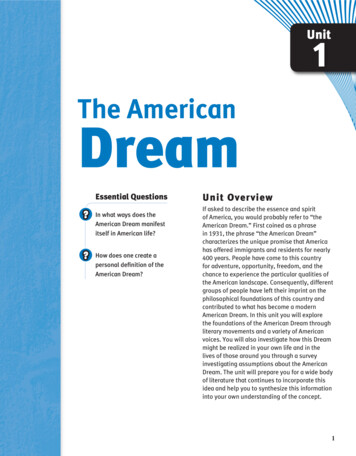
Transcription
Unit1The AmericanDreamEssential Questions?In what ways does theAmerican Dream manifestitself in American life?How does one create apersonal definition of theAmerican Dream?Unit OverviewIf asked to describe the essence and spiritof America, you would probably refer to “theAmerican Dream.” First coined as a phrasein 1931, the phrase “the American Dream”characterizes the unique promise that Americahas offered immigrants and residents for nearly400 years. People have come to this countryfor adventure, opportunity, freedom, and thechance to experience the particular qualities ofthe American landscape. Consequently, differentgroups of people have left their imprint on thephilosophical foundations of this country andcontributed to what has become a modernAmerican Dream. In this unit you will explorethe foundations of the American Dream throughliterary movements and a variety of Americanvoices. You will also investigate how this Dreammight be realized in your own life and in thelives of those around you through a surveyinvestigating assumptions about the AmericanDream. The unit will prepare you for a wide bodyof literature that continues to incorporate thisidea and help you to synthesize this informationinto your own understanding of the concept.
1The American DreamGoalsC To understand anddefine the concept ofthe American DreamC To identify andsynthesize a variety ofperspectives that existabout the AmericanDreamContentsLearning Focus: Making Text Come to Life. . . . . . . . . . . . . . . . . . . . . . 4Activities:1.1Previewing the Unit . . . . . . . . . . . . . . . . . . . . . . . . . . . . . . . . . . . . . . 51.2What Is the American Dream? . . . . . . . . . . . . . . . . . . . . . . . . . . . . . . 61.3What Is Your Source? . . . . . . . . . . . . . . . . . . . . . . . . . . . . . . . . . . . . . 71.4Coming to America. . . . . . . . . . . . . . . . . . . . . . . . . . . . . . . . . . . . . . . . 8Poetry: “Ellis Island,” by Joseph BruchacPoetry: “Europe and America,” by David Ignatow1.5Historic Pathways to the American Dream . . . . . . . . . . . . . . . . . . . 13Essay: “The Trial of Martha Carrier,” by Cotton MatherEssay: “Moral Perfection,” by Benjamin FranklinAphorisms: “Sayings of Poor Richard,” from Poor Richard’sAlmanack, by Benjamin FranklinEssay: Excerpt from “Self-Reliance,” by Ralph Waldo EmersonMemoir: Excerpt from Walden, “Where I Lived and What I LivedFor,” by Henry David Thoreau1.6America the Beautiful. . . . . . . . . . . . . . . . . . . . . . . . . . . . . . . . . . . . 31Poetry: “America, the Beautiful,” by Katharine Lee BatesPoetry: “America,” by Claude McKayPoetry: “Shine, Perishing Republic,” by Robinson Jeffers1.7America’s Voices: Call and Response . . . . . . . . . . . . . . . . . . . . . . . 35Poetry: “I Hear America Singing,” by Walt WhitmanPoetry: “I, Too, Sing America,” by Langston HughesPoetry: “Indian Singing in Twentieth Century America,”by Gail Tremblay1.8Getting to Know the American Dream. . . . . . . . . . . . . . . . . . . . . . . 41Essay: “They Live the Dream,” by Dan RatherArticle: “Lifelong Dreamer—Vietnam Boat Person,”by Mary-Beth McLaughlin1.9Sentence Structure: Let’s Mix it Up! . . . . . . . . . . . . . . . . . . . . . . . . 51C To conduct a survey anduse primary sourcesas a functional text toprove or disprove anassumptionAcademic VocaBularySurveyPrimary SourceSecondary Source1.10 Money and the American Dream . . . . . . . . . . . . . . . . . . . . . . . . . . . 52Poetry: “Money,” by Dana GioiaDrama: Excerpt from A Raisin in the Sun, by Lorraine HansberryShort Story: “Mammon and the Archer,” by O. Henry SpringBoard English Textual Power Level 6 2010 College Board. All rights reserved.Unit
1.11 Listen While You Work . . . . . . . . . . . . . . . . . . . . . . . . . . . . . . . . . . . 62Song Lyrics: “Harlan Man,” by Steve EarleSong Lyrics: “The Mountain,” by Steve Earle1.12 Working Toward the Dream . . . . . . . . . . . . . . . . . . . . . . . . . . . . . . . 66Poetry: “Who Burns for the Perfection of Paper,” by Martin EspadaNonfiction: Excerpt from Working, “Roberto Acuna Talks AboutFarm Workers,” by Studs Terkel1.13 With Liberty and Access to All? . . . . . . . . . . . . . . . . . . . . . . . . . . . . 72Nonfiction: Excerpt from Nickel and Dimed: On (Not) GettingBy in America, by Barbara Ehrenreich1.14 Creating a Survey About the American Dream. . . . . . . . . . . . . . . . 78Embedded Assessment 1 Presenting Findings from a Survey . . . . 81Learning Focus: Defining Your American Dream. . . . . . . . . . . . . . . . 831.15 The Road to Success. . . . . . . . . . . . . . . . . . . . . . . . . . . . . . . . . . . . . 84Speech: Excerpt from Keynote Speech, 2004 DemocraticNational Convention, by Barack ObamaEssay: “The Right to Fail,” by William Zinsser1.16 Defining the Dream . . . . . . . . . . . . . . . . . . . . . . . . . . . . . . . . . . . . . . 91Embedded Assessment 2 Synthesizing the American Dream. . . . . 92 2010 College Board. All rights reserved.Unit Reflection . . . . . . . . . . . . . . . . . . . . . . . . . . . . . . . . . . . . . . . . . . . . . . 96*Texts not included in these materials.
Learning Focus:Making Text Come to LifeWhether you have seen it in a movie, read about it in a book, watched it ona popular sitcom, heard it from your parents, or viewed it being played outin a presidential campaign, “the American Dream” has become a part of ourculture and a term used in our everyday lives. But what does it mean? Is thereone kind of American Dream, or is it unique to each and every one of us? Moreimportantly, do we all have the same access to that dream?Reading primary and secondary sources exposes you to different viewpointsconcerning the American Dream. Much has been written about the AmericanDream, and many secondary sources provide a more objective look atvarious points of view that have been developed about the American Dream.Encountering a wide variety of points of view allows you to deepen andbroaden your understanding of how this idea came into being and how it haschanged throughout our history.Reading original or primary texts allows you to access the thinking of writersin a certain time period without the filter of another’s analysis. You geta writer’s subjective view of ideas of success, money, work, failure, andaccess—all aspects of the American Dream as it has been articulated throughthe ages. 2010 College Board. All rights reserved.Having the opportunity to conduct your own primary source survey puts youin the position of a researcher testing and validating your own ideas of whatmakes up the American Dream. SpringBoard English Textual Power Level 6
Previewing the UnitActivity1.1SUGGESTED Learning Strategies: Think-Pair-Share, Skimming/Scanning, Marking the Text, Close Reading, KWHL ChartEssential Questions1. In what ways does the American Dream manifest itself in Americanlife?2. How does one create a personal definition of the American Dream?Unit Overview and Learning Focus 2010 College Board. All rights reserved.Predict what you think this unit is about. Use the words or phrases thatstood out to you when you read the Unit Overview and the LearningFocus.Embedded Assessment 1What knowledge must you have (what do you need to know) to succeedon Embedded Assessment 1? What skills must you have (what must yoube able to do)?Unit 1 The American Dream
Activity1.2What Is the “American Dream”?SUGGESTED Learning Strategies: Pair Share, QuickwriteAs you read each statement below, use a scale from 1 – 10 and decideto what extent these ideas are prevalent today. If the idea presented inthe statement is something you are exposed to on a regular basis, rateit a 10. If you do not see evidence of the statement at all, rate it a 1(and remember there are plenty of numbers in between).1. Education is important primarily to increase one’sself-knowledge.2. Individuals’ rights are superior to the needs of society.3. Belief in God has been characteristic of the Americanexperience.4.Mankind is basically evil.5.Education is important primarily to get a job.6.Truth is found in faith.7.Human beings are basically good and getting better.8. Individual liberties must always be controlled bygovernment authority.10.Truth can be found in science.11.The American Dream means making lots of money.12.Hard work equals success.13.Everyone can achieve the American Dream.14. The American Dream includes getting married andhaving children.Quickwrite: Reflect on your rankings. Share your responses with apartner or a small group. You might choose to share your responseswith the whole class. Consider the class discussion and select oneor two statements above. Describe your position in reaction to thestatement(s) and explain the rationale for your thinking. SpringBoard English Textual Power Level 6 2010 College Board. All rights reserved.9. A free press is important to equal rights for everyone.
What Is Your Source?Activity1.3SUGGESTED Learning Strategies: Brainstorming, Graphic OrganizerYou have been exposed to a variety of sources throughout your highschool experience. Some of these sources have been primary sourcesand some have been secondary sources.1. Brainstorm examples of primary and secondary sources, then defineprimary and secondary sources in the space below. Consider thesimilarities and differences and even examples of sources you haveused in the past.Primary Source:Secondary Source:2. Your teacher will provide dictionary definitions of these terms. Copythem below. How close were you? What did you already know andwhat is new? 2010 College Board. All rights reserved.Primary Source:Secondary Source:3. Apply your knowledge to the following list. Next to each example,write either “primary” or “secondary” to identify the type of source.InterviewBiographyBook About the Civil WarOriginal PhotographOriginal Work of ArtArticle Critiquing a Work of ArtWorks of LiteratureHistory bookLettersVideo of a Musical PerformancePoemsUnit 1 The American Dream
Activity1.4Coming to AmericaSUGGESTED Learning Strategies: Brainstorming, Quickwriting,Marking the Text, Graphic Organizer1. Brainstorm a list of characteristics or traits you believe are part of theAmerican Dream. Write your list in the space at the left.2. Quickwrite: Select one trait from your list and write about that trait.“Ellis Island”3. Read the poem “Ellis Island” silently. Volunteer to read the poemaloud to the class or listen while others read. Underline the dreamsand disappointments of the people as they are expressed in thepoem. Discuss the underlined passages with the class.4. Brainstorm about the dreams, hopes, and backgrounds of yourancestors. Share your thoughts in a small group.5. Before reading the poem “Europe and America” complete a briefbiography for yourself. On separate paper, write the followinginformation regarding you and your family (past and present). Thenshare your answers with another student.Literary termsAn image is a mental pictureor sensation created by vividlanguage. Place of birth for you, for your parents and/or grandparents Places lived – you , your parents, and/or grandparents Schools attended – you, your parents, grandparents Significant adults or people in your life Dreams of your parents and/or dreams for yourself Disappointments of your parents and/or disappointments foryourself“Europe and America”6. Read the poem to yourself or listen while your teacher reads thepoem aloud to the class. Highlight images in the poem that show thecontrast between the experiences of the father and son. SpringBoard English Textual Power Level 6 2010 College Board. All rights reserved.Biographical Sketch
PoetryActivity 1.4continuedby Joseph BruchacMy NotesAbout the Author 2010 College Board. All rights reserved.Part Native American, Joseph Bruchac began telling NativeAmerican stories for his own children and published hisfirst book of stories in 1975. An award-winning writer andprofessional storyteller, Bruchac has since written dozensof books for children and adults that seek to promote andpreserve Native American stories and culture. Beyond the red brick of Ellis Islandwhere the two Slovak childrenwho became my grandparentswaited the long days of quarantine,after leaving the sickness,the old Empires of Europe,a Circle Line ship slips easilyon its way to the islandof the tall woman, greenas dreams of forests and meadowswaiting for those who’d workeda thousand yearsyet never owned their own. ike millions of others,LI too come to this island,nine decades the answererof dreams. et only part of my blood loves that memory.YAnother voice speaksof native landswithin this nation.Lands invadedwhen the earth became owned.Lands of those who followedthe changing Moon,knowledge of the seasonsin their veins.510152025Unit 1 The American Dream
Activity 1.4continuedComing to AmericaMy NotesPoetryAbout the AuthorDavid Ignatow was born in Brooklyn, New York, in 1914to Russian immigrants. His early jobs included working ina family butcher shop and a bindery. His poetry, which iswritten in straightforward language, often portrays urbanlife and the lives of the working poor. Ignatow won manyprestigious awards for his poetry before he died in 1997.51015 My father brought the emigrant bundleof desperation and worn threads,that in anxiety as he stumblestumble out distractedly;while I am bedded upon soft green moneythat grows like grass.Thus, between my fatherwho lives on a bed of anguish for his daily bread,and I who tear money at leisure by the roots,where I lie in sun or shade,a vast continent of breezes, storms to him,shadows, darkness to him, small lakes, rough channelsto him, and hills, mountains to him, lie between us.My father comes of a small hellwhere bread and man have been kneaded and bakedtogether.You have heard the scream as the knife fell;while I have sleptas guns pounded offshore10 SpringBoard English Textual Power Level 6 2010 College Board. All rights reserved.by David Ignatow
Activity 1.4continuedDenotation and Connotation in “Europe and America”Denotation refers to the dictionary definition of a word. Connotationrefers to the associations connected to a word. Connotation usually hasa more powerful effect on the reader. It may be a visual image or an ideato ponder.7. Look at the examples listed. Then state the denotation andconnotation of key phrases from the poem “Europe and America.”Discuss the effect that those particular words have on the reader.Choose some words or phrases of your own to analyze (use separatepaper).Word or Phraseemigrant bundle ofdesperationDenotationemigrant: One wholeaves the country ofhis or her birthbundle: A group ofobjects held togetherby tying or wrappingConnotationEffect on the ReaderThe father isassociated with thatwhich is negative,bringing all hishopelessness to thenew world.The words set up thereader to contrast thefather’s experiencewith the son’s.desperation:Recklessness arisingfrom losing all hope 2010 College Board. All rights reserved.bedded on soft greenmoneybed of anguishvast continent ofbreezes, storms tohim8. Create a graphic organizer that compares and contrasts the ideas anddreams of past and present generations.Unit 1 The American Dream 11
Activity 1.4continuedComing to AmericaSentence SynthesisConsider how the effect on the reader might change if you change any ofthe key phrases in “Europe and America.”9. Imagine that instead of “bedded on soft green money,” the poet wereto have written “funded by filthy bills.” How does that change affectthe reader? Write your answer in the space below.10. Now look again at the phrases you examined on your own paper.Exchange the key word(s) in those phrases with different word(s) thathave a similar meaning but different connotation. Reflect on how thechange might affect the reader’s interpretation.New Word or PhraseEffect on Reader 2010 College Board. All rights reserved.Word or Phrase12 SpringBoard English Textual Power Level 6
Historic Pathways to the AmericanDreamActivity1.5SUGGESTED Learning Strategies: Double-Entry Journal, GraphicOrganizer, Discussion GroupsAfter reflecting on the idea of the American Dream and those who camefrom distant lands to find their own pathways to the dream, you willnext look at some historical groups and the imprint they have left on theAmerican Dream through their philosophical underpinnings.You will research a particular historical group and its philosophy inorder to teach fellow students about your findings. You will then, inturn, learn from your peers regarding other philosophies that havepermeated America’s diverse belief systems so that you can makeconnections to the texts and ideas in this unit.1. Read your assigned pieces (which are primary sources) in order toresearch the philosophy that has been assigned to you. For eachsource you analyze, record two to three quotations that grab yourattention. Using a three-column journal, document the source andthe quote in the left-hand column of the paper. In the middle column,write your response to the quote in connection to the philosophyyour group is studying. In the right hand column, note any modernconnections. 2010 College Board. All rights reserved.2. Locate an additional primary source (or excerpt) that adequatelyreflects the philosophy’s identified characteristics. You might havealready done this in your initial research. While this is the individualportion of the assignment, check in with your group members tomake sure you have a diverse set of primary sources so when youreturn to your groups, you will have a blend of voices and experiencesto discuss. You will want to include quotes and responses from thissource in your journal.3. Use your research and journal entries to answer the questions listedon the student page for your topic. Through this process, you shouldhave a firm understanding of the core tenets associated with yourphilosophy.4. Using your research, your understanding of the assigned texts, yourresponses to the questions, and your individual primary sources,create a concept map on chart paper or poster board. Use pictures,symbols, and words to represent the information learned regardingthe specific philosophy. It might also be wise to include a copy or acreated image of the additional primary source you located. Includecharacteristics of the philosophy, major writings, historical andmodern connections, and key people. Present the map to the entireclass. Each group is responsible for giving the class a comprehensiveoverview of its assigned philosophy.Unit 1 The American Dream 13
Activity 1.5continuedHistoric Pathways to the AmericanDreamGroup 1: Puritans1. Research to answer the following questions regarding the Puritans:What is their view of God?What are their values?How do they define truth?Do they have an optimistic or pessimistic view of life? Cite evidence.What are their views of work and worldly success?What is their view of society?Who is their authority?What is their view of education?Do they view man as inherently good, evil, or somewhere in between?Cite evidence.2. Read the excerpt from The New England Primer. Discuss with yourgroup the purpose of reading according to this book. How widespreadwas reading meant to be? What is the image of God and religionpresented by the primer?4. Research Puritans and find at least one primary source which givesfurther insight into and specific examples of their philosophy and howit translated into how they lived.5. Look back at the anticipation guide you completed at the beginning ofthis unit. Identify any Puritan philosophy embedded in the questions.6. How would you define the American Dream according to the Puritans?Explain.14 SpringBoard English Textual Power Level 6 2010 College Board. All rights reserved.3. Read “The Trial of Martha Carrier.” What are the charges againstMartha Carrier? What is the evidence against her? Discuss how thePuritan sense of justice and evidence is on trial in this presentation ofthe Salem witch trials of 1692.
Activity 1.5continuedGroup 2: RevolutionariesResearch to answer the following questions regarding theRevolutionaries:What is their view of God?What are their values?How do they define truth?Do they have an optimistic or pessimistic view of life? Cite evidence.What are their views of work and worldly success?What’s their view of society?Who is their authority?What’s their view of education?Do they view man as inherently good, evil, or somewhere in between?Cite evidence. 2010 College Board. All rights reserved.On your own paper define the term perfection. Define moral. Find bothterms in a dictionary and compare the definitions. Do you believe it ispossible for a person to achieve moral perfection? Write a paragraphin which you take a pro or con position. Support your thesis withexamples from personal observation, reading, or experience. Share yourparagraph with your group and discuss.Read “Moral Perfection” from The Autobiography of Benjamin Franklin.Discuss the qualities that Franklin chose in his autobiography andcompare them to the details you included in your paragraph as well asthe paragraphs of your group members. Do you think trying to arrive atmoral perfection is a worthwhile goal? If it is, what does it show about aperson who would try to do this?Create your own list of virtues for yourself. State how you will try toachieve each virtue.Read the “Sayings of Poor Richard,” from Poor Richard’s Almanack byBenjamin Franklin. Discuss these sayings in your group. Choose at leastfive and rewrite them for a modern audience.Research the Revolutionaries and find at least one primary sourcethat provides additional insight into and specific examples of theirphilosophy. How did that philosophy translate into how they lived?Look back on the anticipation guide you completed at the beginning ofthis unit. Identify Revolutionary ideas embedded in the questions.How would you define the American Dream according to theRevolutionaries? Explain.Unit 1 The American Dream 15
Activity 1.5continuedHistoric Pathways to the AmericanDreamGroup 3: TranscendentalistsResearch to answer the following questions regarding theTranscendentalists:What is their view of God?What are their values?How do they define truth?Do they have an optimistic or pessimistic view of life? Cite evidence.What are their views of work and worldly success?What is their view of society?Who is their authority?What is their view of education?Do they view man as inherently good, evil, or somewhere in between?Cite evidence.Read the excerpt from Walden. As you read, underline or highlightspecific examples of Transcendentalist philosophy. Write the connectionin the margin. In your group, summarize Thoreau’s criticisms of society.Identify a facet of modern society that Thoreau would object to andexplain why he would find it objectionable.Research Transcendentalists and find at least one primary sourcethat provides additional insight into and specific examples of theirphilosophy. How did that philosophy translate into how they lived?Look back on the anticipation guide you completed at the beginning ofthis unit. Identify Transcendentalist ideas embedded in the questions.16 SpringBoard English Textual Power Level 6 2010 College Board. All rights reserved.Read the excerpt from “Self-Reliance.” Pick two or three passages fromthe selection that state a strong opinion. Write a personal response tothe passages.
Activity 1.5continuedThe New England Primer 2010 College Board. All rights reserved.For more than a hundred years Puritan childrenreceived their first schooling from The NewEngland Primer. Since the chief purpose ofeducation in Puritan times was to enablepeople to read the Bible, it was natural thatthe alphabet rhymes chanted by the childrenshould be based on Bible stories. The Primeris believed to have been in existence by 1688.Several versions have been printed, often withdifferent verses for the letters.AIn Adam’s Fall,We sinned all.BHeaven to find;The Bible Mind.CChrist crucify’dFor sinners dy’d.DThe Deluge drown’dThe Earth around.EElijah hid,By Ravens fed.FThe judgment madeFelix afraid.GAs runs the Glass,Our Life doth pass.NNoah did viewThe old world & new.TYoung TimothyLearnt sin to fly.HMy Book and HeartMust never part.OVVashti for PrideWas set aside.JJob feels the Rod,Yet blesses God.Young Obadias,David, Josias,All were pious.Whales in the Sea,God’s Voice obey.KPWProud Korah’s troopWas swallowed upPeter deny’dHis Lord and cry’d.Lot fled to Zoar,Saw fiery ShowerOn Sodom pour.QXLQueen Esther suesAnd saves the Jews.Xerxes did die,And so must I.RYoung pious Ruth,Left all for Truth.YWhile youth do chearDeath may be near.SYoung Sam’l dear,The Lord did fear.ZZaccheus heDid climb the TreeOur Lord to see.MMoses was heWho Israel’s HostLed thro’ the Sea.Unit 1 The American Dream 17
Historic Pathways to the AmericanDreamActivity 1.5continuedMy NotesEssayAbout the AuthorCotton Mather entered Harvard University at the age of12 and became an influential Puritan minister who wroteover 400 works. Some of his works describe the Puritanbeliefs in the spiritual world and in the work of the devilin promoting witchcraft. He wrote reports to the judges ofthe Salem witch trials and then a history of the trials.&GrammarUsageSentences usually beginor end with the main idea.When the main idea orthe independent clausebegins a sentence, it isa cumulative sentence:“Martha Carrier wasindicted for bewitchingcertain persons, accordingto the form usual in suchcases, pleading not guiltyto her indictment.” Whenthe independent clausecomes at the end, thesentence is periodic.Thoreau writes, “For mypart, I could easily dowithout the post office.”I. Martha Carrier was indicted for bewitching certain persons, accordingto the form usual in such cases, pleading not guilty to her indictment1. Therewere first brought in a considerable number of the bewitched persons,who not only made the Court sensible of any horrid witchcraft committedupon them, but also deposed2 that it was Martha Carrier, or her shape, thatgrievously tormented them by biting, pricking, pinching, and choking ofthem. It was further deposed that while this Carrier was on her examinationbefore the Magistrates3, the poor people were so tortured that every oneexpected their death upon the very spot, but that upon the binding of Carrierthey were eased. Moreover, the look of Carrier then laid the afflicted peoplefor dead, and her touch, if her eye at the same time were off them, raised themagain: which things were also now seen upon her trial. And it was testifiedthat upon the mention of some having their necks twisted almost round, bythe shape of this Carrier, she replied, It’s no matter though their necks had beentwisted quite off.II. Before the trial of this prisoner, several of her own children had franklyand fully confessed not only that they were witches themselves, but thatthis mother had made them so. This confession they made with great showsof repentance, and with much demonstration of truth. They related place,123indictment: accusation or blamedeposed: testified under oathmagistrate: a judge18 SpringBoard English Textual Power Level 6 2010 College Board. All rights reserved.by Cotton Mather
Activity 1.5continuedtime, occasion; they gave an account of journeys, meetings, and mischiefs bythem performed and were very credible in what they said. Nevertheless, thisevidence was not produced against the prisoner at the bar, inasmuch as therewas other evidence enough to proceed upon.My NotesIII. Benjamin Abbot gave his testimony that last March was atwelvemonth, this Carrier was very angry with him, upon laying out someland near her husband’s. Her expressions in this anger were that she wouldstick as close to Abbot as the bark stuck to the tree, and that he should repent ofit afore seven years came to an end, so as Doctor Prescot should never cure him.These words were heard by others besides Abbot himself, who also heard hersay she would hold his nose as close to the grindstone as ever it was held sincehis name was Abbot. Presently after this he was taken with a swelling in hisfoot, and then with a pain in his side, and exceedingly tormented. It bred intoa sore, which was lanced4 by Doctor Prescot, and several gallons of corruptionran out of it. For six weeks it continued very bad, and then another sore bredin the groin, which was also lanced by Doctor Prescot. Another sore thenbred in his groin, which was likewise cut and put him to very great misery. Hewas brought until death’s door and so remained until Carrier was taken andcarried away by the Constable, from which very day he began to mend and sogrew better every day and is well ever since. 2010 College Board. All rights reserved.Sarah Abbot, his wife, also testified that her husband was not only allthis while afflicted in his body, but also that strange, extraordinary, andunaccountable calamities5 befell his cattle, their death being such as theycould guess at no natural reason for.IV. Allin Toothaker testified that Richard, the son of Martha Carrier,having some difference with him, pulled him down by the hair of the head.When he rose again, he was going to strike at Richard Carrier, but fell downflat on his back to the ground and had not power to stir hand or foot until hetold Carrier he yielded: and then he saw the shape of Martha Carrier go offhis breast.This Toothaker had received a wound in the wars and now testifiedthat Martha Carrier told him he should never be cured. Just afore theapprehending of Carrier, he could thrust a knitting needle into his wound,four inches deep; but presently, after her being seized, he was thoroughlyhealed.He further testified that when Carrier and he sometimes were atvariance, she would clap her hands at him, and say he should get nothing byit; whereupon he several times lost his cattle by strange deaths, whereof nonatural ca
Dream Unit Overview If asked to describe the essence and spirit of America, you would probably refer to “the American Dream.” First coined as a phrase in 1931, the phrase “the American Dream” characterizes the unique promise that America has offered immigrants and residen

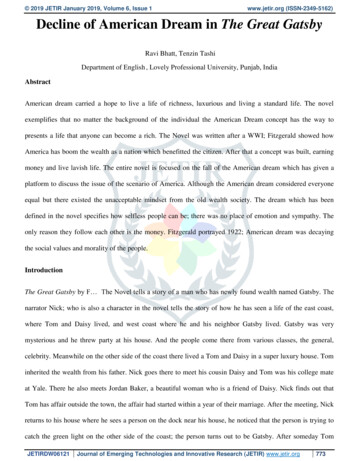
![Requiem For The American Dream [Transcript]](/img/13/requiem-for-the-american-dream-transcript.jpg)

